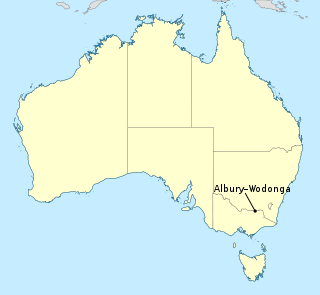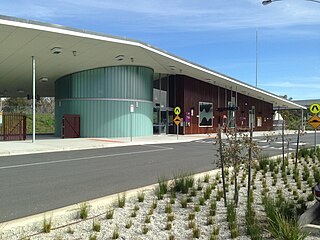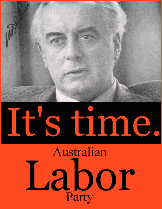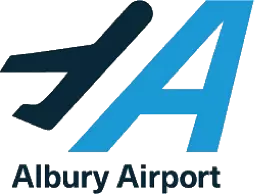
Albury–Wodonga is the broad settlement incorporating the twin Australian cities of Albury and Wodonga, which are separated geographically by the Murray River and politically by a state border: Albury on the north of the river is part of New South Wales, while Wodonga on the south bank is in Victoria.

Albury is a major regional city in New South Wales, Australia. It is located on the Hume Highway and the northern side of the Murray River. Albury is the seat of local government for the council area which also bears the city's name – the City of Albury. It is on the Victoria–New South Wales border.

Wodonga is a city on the Victorian side of the border with New South Wales, 300 kilometres (190 mi) north-east of Melbourne, Australia. It is located wholly within the boundaries of the City of Wodonga LGA. Its population is approximately 35,100 and is separated from its twin city in New South Wales, Albury, by the Murray River. Together, the two cities form an urban area with an estimated population of 93,603. There are multiple suburbs of Wodonga including Bandiana, Baranduda, Barnawartha, Bonegilla, Ebden, Huon Creek, Killara, Leneva and Staghorn.

Hume Highway, inclusive of the sections now known as Hume Freeway and Hume Motorway, is one of Australia's major inter-city national highways, running for 840 kilometres (520 mi) between Melbourne in the southwest and Sydney in the northeast. Upgrading of the route from Sydney's outskirts to Melbourne's outskirts to dual carriageway was completed on 7 August 2013.

The City of Wodonga is a local government area in the Hume region of Victoria, Australia, located in the north-east part of the state. It covers an area of 433 square kilometres (167 sq mi) and in June 2018, had a population of 41,429.

Wodonga railway station is located on the North East line in Victoria, Australia. It serves the city of Wodonga, and it opened on 25 June 2011.

In Australia, electoral districts for the Australian House of Representatives are called divisions or more commonly referred to as electorates or seats. There are currently 151 single-member electorates for the Australian House of Representatives.

Gerogery is a town established on Wiradjuri land in the Riverina region of the Australian state of New South Wales. The town is in the Greater Hume Shire local government area and on the Main South railway line between Sydney and Melbourne, where it intersects with the Olympic Highway. Gerogery serves a rural farming community. Gerogery has a temperate climate. It lies close to the Great Yambla Range, with its striking Tabletop and Sugar Loaf ridge at the southern end.
Louis Stuart Lieberman is an Australian politician and was a member of both the Victorian Legislative Assembly and the Australian House of Representatives.

It's Time was a successful political campaign run by the Australian Labor Party (ALP) under Gough Whitlam at the 1972 federal election in Australia. Campaigning on the perceived need for change after 23 years of conservative government, Labor put forward a raft of major policy proposals, accompanied by a television advertising campaign of prominent celebrities singing a jingle entitled It's Time. It was ultimately successful, as Labor picked up eight seats and won a majority. This was the first time Labor had been in government since it lost the 1949 federal election to the Liberal Party.
The North East railway line is a railway line in Victoria, Australia. The line runs from Southern Cross railway station on the western edge of the Melbourne central business district to Albury railway station in the border settlement of Albury–Wodonga, serving the cities of Wangaratta and Seymour, and smaller towns in northeastern Victoria. The line is owned by VicTrack, but the standard gauge section leased to, and maintained by, the Australian Rail Track Corporation.

Albury Airport is a regional airport located 2 nautical miles northeast of Albury, New South Wales, Australia. The airport, which also serves Albury's adjacent twin city of Wodonga, Victoria, was the fifth busiest in New South Wales as of 2016–17, handling 257,769 passengers. However, like most Australian airports, the impacts of travel restrictions and state border closures in response to the COVID-19 pandemic resulted in a significant reduction in revenue passengers. ABX handled 107,934 passengers in the 2021–22 financial year and was the 32nd busiest airport in Australia. In addition to regular public transport flights, Albury airport handles a relatively large number of charter, freight, agricultural, and general aviation aircraft movements and hosts the official weather station for Albury-Wodonga.
A statutory corporation is a government entity created as a statutory body by statute. Their precise nature varies by jurisdiction, but they are corporations owned by a government or controlled by national or sub-national government to the extent provided for in the creating legislation.

Thurgoona is an outer suburb of the regional city of Albury in southern New South Wales, Australia. The suburb is located in the City of Albury local government area.
A statutory body or statutory authority is a body set up by law (statute) that is authorised to implement certain legislation on behalf of the relevant country or state, sometimes by being empowered or delegated to set rules in their field. They are typically found in countries which are governed by a British style of parliamentary democracy such as the United Kingdom and the Commonwealth countries like Australia, Canada, India and New Zealand. They are also found in Israel and elsewhere. Statutory authorities may also be statutory corporations, if created as a body corporate.

East Albury is a suburb of the city of Albury, New South Wales, located 3 kilometres (2 mi) east of the Albury Central Business District. At the 2006 census, East Albury had a population of 5686.
Blasphemy is not a criminal offence under Australian federal law, but the de jure situation varies at state and territory level; it is currently not enforced in any Australian jurisdiction. The offences of blasphemy and blasphemous libel in English common law were carried over to the Australian colonies and "received" into state law following Federation in 1901. The common-law offences have been abolished totally in Queensland and Western Australia, when those jurisdictions adopted criminal codes that superseded the common law. In South Australia, Victoria, and the Northern Territory the situation is ambiguous, as the local criminal codes do not mention blasphemy but also did not specifically abolish the common-law offences. In New South Wales and Tasmania, the criminal codes do include an offence of blasphemy or blasphemous libel, but the relevant sections are not enforced and generally regarded as obsolete.
Common law offences are crimes under English criminal law, the related criminal law of some Commonwealth countries, and under some U.S. State laws. They are offences under the common law, developed entirely by the law courts, having no specific basis in statute.
Camden Valley Way is a 23-kilometre (14 mi) arterial road between the southwestern fringes of suburban Sydney and the historic town of Camden. It is a former alignment of Hume Highway.
The wheat industry of Australia has been organised by government regulation, by both the Commonwealth Government and state governments.












